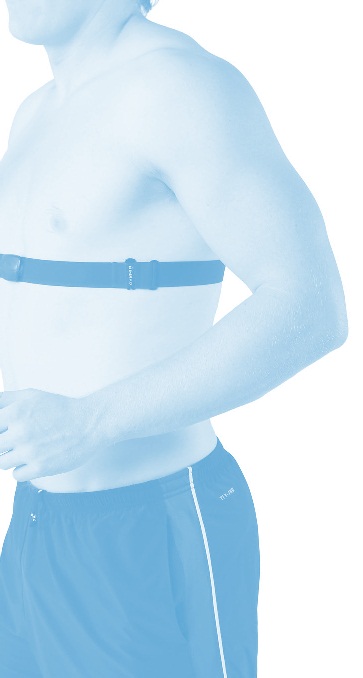
The term “cardio” has become synonymous with endurance training. In fact, most runners think it’s where conditioning begins. So you might be perplexed as to why we’ve waited until now to address the cardiovascular system. Don’t be. First, you don’t build your running body one component at a time; you build components simultaneously. Second, many improvements in cardio don’t require you to target your cardiovascular system directly; instead, your cardiovascular system gets fit because you increase your body’s demand for fuel, which the exercises in chapters 5 and 6 will certainly help you accomplish.
Cardio is the fuel delivery system for your running body. It supplies the steady stream of oxygen, energy (e.g., carbohydrates, proteins, and fats), water, and hormones that your body needs to function. But that’s not all. It doubles as the garbage collector, carrying away waste products like carbon dioxide, acidic hydrogen ions, and even heat.
It should come as no surprise that improved running requires improved fuel service and increased garbage collection. Luckily for you, your cardiovascular system runs on supply and demand—if you increase demand from your running body, your cardiovascular system will increase supply. It will transform from the equivalent of an ancient Roman aqueduct into a high-performance twenty-first-century utility, complete with a powerful pumping station and miles of reinforced pipelines.
At its simplest, the cardiovascular system is a blood-distribution network. But that’s like saying the government is a rule-distribution network. The truth is that the cardiovascular system comprises a biological supply-and-demand infrastructure of almost unfathomable scope. It has your heart as its engine, beating one hundred thousand times per day to pump almost two thousand gallons of blood. It boasts approximately sixty thousand miles of blood vessels—enough to circumnavigate the globe two and a half times or to stretch a quarter of the way to the moon. And it utilizes twenty to thirty trillion red blood cells (RBCs) to carry oxygen to the one hundred trillion cells in your body.
And that’s before you train. If you’ve played Monopoly, you can think of training as like plunking down houses and hotels on your cardiovascular “properties”—you’re making an investment that will provide a substantial return, including a stronger heart, even more miles of blood vessels, and a higher volume of RBCs.
As a runner, you should think of your cardiovascular system as an oxygen transport system. Its number-one job during training and racing is to transport oxygen from your lungs to your skeletal and cardiac (heart) muscle cells.
In this chapter, we’ll discuss three main features of the cardiovascular system:
Because lungs (part of the respiratory system) supply the oxygen transported by the cardiovascular system, we’ll also do a quick drive-by and explore a training strategy for improving their strength.
If you guessed that training your cardiovascular system involves a lot of running, you’re right. And just as you utilized different paces to train different muscle fiber types in Chapter 5, you’ll use multiple paces to target specific areas of cardiovascular fitness.
You actually began your cardiovascular training with the first runs (or walks) you did while strengthening your muscles. Now, it’s time to build upon that base. You’ll need to elevate both volume and intensity. Some of the workouts you can use to do that are:
Each of these types of training has a specific effort level (often defined by pace) attached to it. Increasing the volume or intensity of any workout won’t result in an advantage; more likely, it will sabotage the desired stimulus and adaptation.
The heart has captured the imaginations of poets and philosophers since we humans first felt its beat within our chests. The ancient Egyptians considered the heart to be a receptacle for the soul. Aristotle claimed that it was the seat of intelligence and sensation. The Catholic Church, at the Council of Vienna in 1311, dubbed it the wellspring for emotion, nutrition, and vitality. And a couple hundred years later, it was redefined as the cradle of love. It took Rene Descartes, the seventeenth-century philosopher and mathematician—“Cogito ergo sum” (I think; therefore, I am)—to declare the heart to be nothing more than a mechanical pump.
Modern runners—armed with a few hundred years of training experimentation—have transformed that simple pump, an organ composed of specialized cardiac muscle tissue that can beat nonstop for a lifetime, into the engine that’s driven the fitness revolution.
Your heart is located near the middle of your chest, tucked between your lungs. About the size of your clenched fist, it has four chambers—two upper atriums and two lower ventricles—arranged like a duplex. On the right side of your heart, the upper atrium receives deoxygenated blood from your body, then transfers it into the lower ventricle, from which it’s pumped to the lungs. On the left side of your heart, your left atrium receives newly oxygenated blood from the lungs, then transfers it to the left ventricle, from where it’s pumped into the aorta, your largest artery, and then to the rest of your body. A normal, adult heart beats sixty to one hundred times per minute, making a “lub-dub” sound with each beat. The “lub” is the closing of the valves between the atriums and ventricles, after blood has been pumped into the ventricles. The “dub” is the sound of the ventricular valves closing after blood has been pumped toward the lungs and into the aorta. During your lifetime, your heart will pump approximately one million barrels of blood, enough to fill an average-size oil tanker!
Your training goal for the heart is simple: Increase its pumping capacity.
The amount of blood your heart can pump in a minute is called your cardiac output. The more blood you pump, the more oxygen you send to your muscle fibers. This increases your fibers’ ability to work aerobically, which is the key to endurance training and racing. Cardiac output is determined by two factors:
Table 7.1 Cardiac Output During 5K/10K
|
5K Time |
10K Time |
Cardiac Output (Liters/Minute)* |
|---|---|---|
|
At Rest |
4.5–5.5 |
|
|
14:00 |
29:10 |
30.5–36.5 |
|
15:00 |
31:15 |
28.3–34.0 |
|
16:00 |
33:20 |
26.4–31.7 |
|
17:00 |
35:25 |
24.8–29.8 |
|
18:00 |
37:30 |
23.4–28.0 |
|
19:00 |
39:35 |
22.1–26.5 |
|
20:00 |
41:40 |
20.9–25.1 |
|
21:00 |
43:45 |
19.8–23.8 |
|
22:00 |
45:50 |
18.9–22.7 |
|
23:00 |
47:55 |
18.0–21.6 |
|
24:00 |
49:60 |
17.2–20.7 |
|
25:00 |
52:05 |
16.5–19.8 |
|
26:00 |
54:10 |
15.8–19.0 |
|
28:00 |
58:20 |
14.6–17.6 |
|
30:00 |
1:02:30 |
13.6–16.3 |
|
32:00 |
1:06:40 |
12.7–15.3 |
|
34:00 |
1:10:50 |
11.9–14.3 |
|
36:00 |
1:14:60 |
11.2–13.5 |
|
38:00 |
1:19:10 |
10.6–12.7 |
|
40:00 |
1:23:20 |
10.0–12.0 |
|
42:00 |
1:27:30 |
9.5–11.4 |
TABLE 7.1 offers estimates of cardiac output associated with 5K/10K times. Find your 5K or 10K time in the columns on the left, then find your predicted cardiac output in the column on the right. Cardiac output measures the blood your heart pumps in liters per minute.
*Ranges allow for differences in body weight.
If you multiply stroke volume by heart rate, the result is your cardiac output. At rest, an average person will pump five liters of blood per minute. While running, your cardiac output increases significantly. Table 7.1 estimates the cardiac output required for different 5K/10K race efforts.
If you want to improve your running performance—either for workouts or races—you must improve your cardiac output. This means increasing your stroke volume or heart rate. Unfortunately, your maximum heart rate (the most times your heart can beat in a minute) is determined by genetics and can’t be changed. That leaves stroke volume. Fortunately, stroke volume can be improved—a lot!
Stroke volume can refer to the amount of blood being pumped from either ventricle, which in healthy adults is roughly equal. As a runner, however, you’ll focus on your left ventricle, which pumps blood throughout your body (the right ventricle pumps blood along a short loop to the lungs and back). When you increase your stroke volume, you increase the amount of blood—hence, oxygen—that you can transport to your muscles. This is accomplished in two ways:
Interval training is the workout of choice for improving stroke volume. First introduced by Dr. Woldemar Gerschler and Dr. Hans Reindell in the 1930s, an interval workout includes short, fast repetitions followed by recovery “intervals,” during which you jog or walk. The goal is to increase your heart rate during the repetition, then allow it to slow down during the recovery. While increased blood flow during the repetition is important, it’s the recovery interval that’s vital. During recovery, your heart rate drops more quickly than the corresponding drop in blood flow. This forces the ventricles to fill more fully, creating a brief increase in stroke volume. Repeated over multiple reps, this stimulus triggers an adaptation: Increased stroke volume.
Stroke volume is one of the greatest determinants of running performance. Unfit runners reach their maximum stroke volume while they’re jogging. In contrast, trained runners increase stroke volume up to 5K pace or faster. That’s a huge oxygen advantage.
When you train your heart, your heart does what human tissue does best: It adapts. Cardiac muscle fibers get bigger. Your heart’s connective tissue gets stronger. Your ventricular chambers grow larger. Your stroke volume goes up. And your resting heart rate goes down (see sidebar, “Will running lower my resting heart rate?” page 113).
Your blood vessels are your supply lines, allowing the 24/7 transport of oxygen, nutrients, hormones, and water to every cell in your body. Large blood vessels called arteries carry oxygen-rich blood away from your heart. This journey begins with your aorta, then branches into smaller arteries, then into even smaller arterioles, and finally into the tiniest blood vessels in your body, your capillaries. Capillaries are so small that red blood cells must pass through them in single file. It’s your capillaries that bring blood to your muscle fibers, offloading oxygen and nutrients while picking up carbon dioxide and other waste products. Capillaries then guide blood into venules, which drain into veins, which finally steer blood back to your heart.
Every warehouse has a loading bay—an area where goods are either loaded or unloaded—that’s serviced by a steady fleet of cargo trucks. Capillary beds are your muscle fibers’ loading bays, with RBCs serving as cargo trucks. These beds are the exchange zone for oxygen and carbon dioxide, for nutrients and wastes.
The most important thing for you to remember about capillaries is this: More is better.
The more capillaries you have serving each muscle fiber, the more oxygen you can bring to that fiber (and the more carbon dioxide and other waste products you can haul away). Table 7.2 estimates total capillaries for several runners of varying ability. You’ll note that as runners get faster, their predicted capillary density for each fiber type increases.
New capillaries begin to develop during the first week of training, but they only grow for muscle fibers that are being recruited. Riding a bike may be good for your heart, but it won’t grow capillaries around non-biking muscle fibers. Similarly, if you run all slow distance, you’ll develop capillaries around slow-twitch muscle fibers but not around faster fibers. There are five ways to stimulate capillary growth:
Table 7.2 Average Capillaries Per Fiber Type
|
5K Time |
10K Time |
Slow-Twitch |
Intermediate |
Fast-Twitch |
|---|---|---|---|---|
|
14:00 |
29:10 |
5.6 |
4.2 |
2.8 |
|
15:00 |
31:15 |
5.4 |
4.0 |
2.7 |
|
18:00 |
37:30 |
4.5 |
3.4 |
2.2 |
|
21:00 |
43:45 |
3.6 |
2.7 |
1.8 |
|
24:00 |
50:00 |
2.8 |
2.1 |
1.4 |
|
27:00 |
56:15 |
1.9 |
1.4 |
0.9 |
|
30:00 |
1:02:30 |
2.2 |
1.7 |
1.1 |
|
34:00 |
1:10:50 |
1.9 |
1.5 |
1.0 |
|
38:00 |
1:19:10 |
1.7 |
1.3 |
0.8 |
|
42:00 |
1:27:30 |
1.5 |
1.1 |
0.8 |
TABLE 7.2 predicts the number of capillaries you’ll have associated with each muscle fiber based upon your 5K/10K time. Find your 5K or 10K time in the columns on the left, then find your predicted number of capillaries for each fiber type in the columns on the right.
Increased capillarization (capillary growth) is the only way to ensure delivery of the increased oxygen supply created by improved stroke volume.
A common complaint among runners is that fitness takes forever to improve and no time at all to lose. Unfortunately, capillaries follow this pattern. When you stop training, you lose all your new hard-earned capillaries in as little as seven days. If you simply lower your training volume or intensity, you’ll lose all capillary gains associated with the previous volume or intensity. Simply put, when you reduce blood flow, you reduce capillaries.
There’s another thing worth mentioning when it comes to capillary growth: Exercising too hard sabotages it. Think of training as baking a cake. Putting in twice the flour and triple the salt does not a better cake make. Same goes for extra intervals and faster paces than prescribed.
Like every other part of the cardiovascular system, your blood improves with training. The first improvement begins within hours or days of your first run: Your plasma volume increases. Increased plasma volume reduces your blood’s viscosity (resistance), making it easier for blood to flow through blood vessels, especially the capillaries.
While all running improves blood volume, a 2012 study from New Zealand documented significantly increased plasma volume and performance following training in the heat, with the stipulation that mild dehydration (no more than 2 percent) must be allowed to occur to reap the full benefit. Runner’s World’s Alex Hutchinson noted in his blog, Sweat Science, that studies like this illustrate “the importance of allowing your body to undergo training-induced stresses, rather than making heroic efforts to cushion your body from discomfort . . . [Leaving] the water bottle at home may be a good call.”
Table 7.3 Total Liters of Blood at Rest
|
Weight (Pounds) |
Male |
Female |
||||
|---|---|---|---|---|---|---|
|
Untrained |
Trained |
Elite |
Untrained |
Trained |
Elite |
|
|
250 |
8.9 |
10.5 |
12.2 |
6.7 |
7.8 |
9.1 |
|
225 |
8.0 |
9.4 |
11.0 |
6.0 |
7.1 |
8.2 |
|
200 |
7.1 |
8.4 |
9.7 |
5.3 |
6.3 |
7.3 |
|
175 |
6.2 |
7.3 |
8.5 |
4.7 |
5.5 |
6.4 |
|
150 |
5.3 |
6.3 |
7.3 |
4.0 |
4.7 |
5.5 |
|
125 |
4.4 |
5.2 |
6.1 |
3.3 |
3.9 |
4.6 |
|
100 |
3.6 |
4.2 |
4.9 |
2.7 |
3.1 |
3.7 |
|
75 |
2.7 |
3.1 |
3.7 |
2.0 |
2.4 |
2.7 |
TABLE 7.3 approximates the total liters of blood in your body based upon your weight and your relative level of fitness. Find the weight that is closest to your own in the column on the left, then find the associated blood volume based on your gender/fitness in the columns on the right.
The other big adaptation in your blood is an increased number of red blood cells (RBCs). RBCs carry 98 percent of the oxygen that your body uses (and also participate heavily in the removal of carbon dioxide). Oxygen is picked up at the lungs, where it binds to RBCs’ iron-rich hemoglobin molecules—it’s iron that gives RBCs (and your blood) their red color. Increasing your volume of RBCs allows your blood to transport more oxygen.
RBC volume expands more slowly than plasma volume, taking weeks or even months to plasma’s days. Eventual gains in overall RBC volume occur even as exercise-induced damage reduces their expected lifespan from 120 days to approximately 70. This damage is theorized to occur due to causes ranging from exposure to oxygen (causing oxidative stress) to “foot-strike hemolysis,” in which RBCs are destroyed when your feet pound the pavement. Still, few runners end up suffering from true anemia (not counting the brief period when plasma expansion outpaces that of RBCs, sometimes called “sports anemia”), and RBC production soon exceeds its normal rate of production, which is 2 million RBCs per second. A 1995 study from the Australian Institute of Sport suggests that there’s a benefit from the shorter lifespan of RBCs in runners: “[It] may be advantageous because young cells are more efficient in transporting oxygen.”
The lungs are part of the respiratory system, but they’re also the portal through which oxygen enters the cardiovascular system—and they’re trainable.
Your lungs are much more than balloons. They are not two hollow chambers that inflate and deflate with each breath. Instead, the interior of your lungs has the consistency of a sponge, filled with complex networks of bronchi and bronchioles (air passageways) that end in tiny air sacs called alveoli. How many alveoli? Anywhere from three hundred million to eight hundred million per lung. Alveoli are wrapped in capillaries, and it’s here that your blood exchanges carbon dioxide for oxygen. The sheer number of alveoli, capillaries, and RBCs in the lungs explains why smokers can destroy so much lung tissue and still get oxygen into their blood.
You train your lungs by strengthening your respiratory muscles. To inhale, you contract your diaphragm and external intercostal muscles. This expands your chest, which lowers air pressure in your chest cavity and ultimately causes your lungs to fill with air. When you relax the same muscles, you exhale. When you’re running like a maniac during hard workouts or races—what some runners joylessly refer to as sucking wind—you engage other respiratory muscles (abdominals and internal intercostals) to help you exhale faster.
Table 7.4 Training Effects of Workouts
|
Training |
Stroke Volume |
Blood Volume |
Red Blood Cells |
Lungs (Muscles) |
Capillaries (Slow-Twitch) |
Capillaries (Intermediate) |
|---|---|---|---|---|---|---|
|
1500m Pace Intervals |
Very High |
Moderate |
Moderate |
Very High |
Low |
Very High |
|
3K Pace Intervals |
Very High |
Very High |
High |
High |
Moderate |
High |
|
5K Pace Intervals |
High |
Very High |
High |
High |
Moderate |
High |
|
10K Pace Intervals |
High |
High |
Moderate |
Moderate |
High |
Moderate |
|
Cruise Intervals |
Moderate |
High |
Moderate |
Moderate |
Very High |
Moderate |
|
Fast Tempo |
Moderate |
High |
Moderate |
Moderate |
Very High |
Moderate |
|
Slow Tempo |
Moderate |
High |
Moderate |
Moderate |
Very High |
Moderate |
|
Long Run |
Moderate |
Moderate |
Moderate |
Moderate |
High |
Moderate |
|
Hill Reps |
High |
Moderate |
Moderate |
Very High |
Low |
Very High |
|
Regular Run |
Moderate |
Moderate |
Moderate |
Moderate |
Moderate |
Moderate |
|
Easy Run |
Low |
Moderate |
Low |
Low |
Moderate |
Low |
|
Lung Inspiration Devices |
Very Low |
NA |
NA |
Very High |
NA |
NA |
TABLE 7.4 looks at the effect of various types of training on different aspects of your cardiovascular system. For example, hill repeats have a very high effect on capillaries in intermediate fibers, increasing the number of capillaries signifcantly. On the other hand, they have a low effect on slow-twitch capillaries, which require longer duration running, such as tempo runs, to stimulate similar increases in capillary density.
Stronger respiratory muscles not only lower the psychological stress from sucking wind, they also lower your energy use. At rest, breathing accounts for about 1 percent of your energy use. During hard running, this figure can rise to 9 percent. Cutting that down by a few percentage points leaves more energy for the rest of your running body. And training these muscles works. A 2011 study on endurance cyclists found that respiratory conditioning resulted in a 34 percent increase in respiratory muscle strength and a 38 percent increase in respiratory muscle endurance.
Cardiovascular system training involves the interval and tempo running that most runners associate with race conditioning. Important training in this chapter’s photo instruction includes:
Training from other chapters that affects cardiovascular system improvements includes:
To see exactly how these workouts can be incorporated into your overall training program, skip directly to Chapter 15: Build Your Training Schedule, where sample schedules are available for runners of all fitness levels and abilities.
In the chapter on muscles, you were introduced to some basic running workouts, from strides to easy running—even some hills. As you begin to tackle the challenge of developing your cardiovascular system, you’ll need to engage in more-intense training. Grace returns to demonstrate proper stride and form for each workout. To aid in your understanding of this training, each running workout is accompanied by the following:
1500-meter pace effort is equivalent to the effort you’d use to race a mile. Since most runners haven’t raced the 1500 or the mile, the pace table uses your 5K race pace as a starting point, then estimates an equivalent 1500-meter performance. If you don’t have a current 5K time, use the guidelines outlined on page 34. 1500-pace suggestions are given for repetitions at 200, 300, 400, and 600 meters. Repetitions longer than 600 meters are not advised. 1500-pace reps can improve:
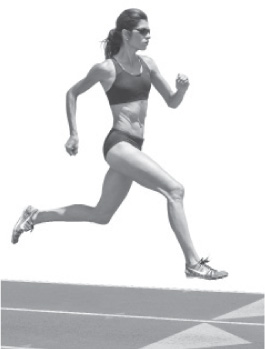
1500-Meter Pace Training Table
|
5K Time |
1500m Time |
Repetition Paces |
||||
|---|---|---|---|---|---|---|
|
600m |
400m |
300m |
200m |
100m |
||
|
14:00 |
3:49 |
1:32 |
1:00 |
0:46 |
0:31 |
NA |
|
14:30 |
3:57 |
1:35 |
1:03 |
0:47 |
0:32 |
NA |
|
15:00 |
4:05 |
1:38 |
1:05 |
0:49 |
0:33 |
NA |
|
15:30 |
4:13 |
1:41 |
1:08 |
0:51 |
0:34 |
NA |
|
16:00 |
4:21 |
1:45 |
1:10 |
0:52 |
0:35 |
NA |
|
16:30 |
4:30 |
1:48 |
1:12 |
0:54 |
0:36 |
NA |
|
17:00 |
4:38 |
1:51 |
1:14 |
0:56 |
0:37 |
NA |
|
17:30 |
4:46 |
1:54 |
1:16 |
0:57 |
0:38 |
NA |
|
18:00 |
4:54 |
1:58 |
1:18 |
0:59 |
0:39 |
NA |
|
18:30 |
5:02 |
2:00 |
1:21 |
1:01 |
0:40 |
NA |
|
19:00 |
5:10 |
2:04 |
1:23 |
1:02 |
0:41 |
NA |
|
19:30 |
5:19 |
2:07 |
1:25 |
1:04 |
0:43 |
NA |
|
20:00 |
5:27 |
2:11 |
1:27 |
1:05 |
0:44 |
NA |
|
20:30 |
5:35 |
2:14 |
1:29 |
1:07 |
0:45 |
NA |
|
21:00 |
5:43 |
2:17 |
1:32 |
1:09 |
0:46 |
NA |
|
21:30 |
5:51 |
2:21 |
1:34 |
1:10 |
0:47 |
NA |
|
22:00 |
5:59 |
2:24 |
1:36 |
1:12 |
0:48 |
NA |
|
22:30 |
6:08 |
2:27 |
1:38 |
1:14 |
0:49 |
NA |
|
23:00 |
6:16 |
2:30 |
1:40 |
1:15 |
0:50 |
NA |
|
23:30 |
6:24 |
2:34 |
1:42 |
1:17 |
0:51 |
NA |
|
24:00 |
6:32 |
2:37 |
1:45 |
1:18 |
0:52 |
NA |
|
24:30 |
6:40 |
2:40 |
1:47 |
1:20 |
0:53 |
NA |
|
25:00 |
6:50 |
2:43 |
1:49 |
1:22 |
0:55 |
NA |
|
26:00 |
7:05 |
2:50 |
1:53 |
1:25 |
0:57 |
NA |
|
27:00 |
7:21 |
2:57 |
1:58 |
1:28 |
0:59 |
NA |
|
28:00 |
7:38 |
NA |
2:02 |
1:32 |
1:01 |
0:30 |
|
29:00 |
7:54 |
NA |
2:06 |
1:35 |
1:03 |
0:32 |
|
30:00 |
8:10 |
NA |
2:11 |
1:38 |
1:05 |
0:33 |
|
31:00 |
8:27 |
NA |
2:15 |
1:41 |
1:08 |
0:34 |
|
32:00 |
8:43 |
NA |
2:19 |
1:45 |
1:10 |
0:35 |
|
33:00 |
8:59 |
NA |
2:24 |
1:48 |
1:12 |
0:36 |
|
34:00 |
9:16 |
NA |
2:28 |
1:51 |
1:14 |
0:37 |
|
35:00 |
9:32 |
NA |
2:33 |
1:54 |
1:16 |
0:38 |
|
36:00 |
9:48 |
NA |
2:37 |
1:58 |
1:18 |
0:39 |
|
37:00 |
10:05 |
NA |
2:41 |
2:01 |
1:21 |
0:40 |
|
38:00 |
10:21 |
NA |
2:46 |
2:04 |
1:23 |
0:41 |
|
39:00 |
10:37 |
NA |
2:50 |
2:07 |
1:25 |
0:42 |
|
40:00 |
10:54 |
NA |
2:54 |
2:11 |
1:27 |
0:44 |
|
41:00 |
11:10 |
NA |
2:59 |
2:14 |
1:29 |
0:45 |
|
42:00 |
11:26 |
NA |
NA |
2:17 |
1:32 |
0:46 |
Work:Recovery (Time) = 1:1 or 1:2
The maximum recommended duration of a repetition at 1500m pace is 3:00.
3K pace training is the closest most runners come to VO2 max effort. The pace table uses your 5K race pace as a starting point and then estimates your equivalent 3K pace, offering suggestions for repetitions at 200, 400, 600, 800, and 1000 meters. If you don’t have a current 5K time, use the guidelines outlined on page 34. Repetitions longer than 1000 meters are not advised. 3K pace reps can improve:
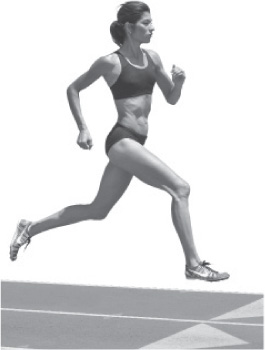
3K Pace Training Table
|
5K Time |
3K Time |
Repetition Paces |
||||
|---|---|---|---|---|---|---|
|
1600m |
800m |
600m |
400m |
200m |
||
|
14:00 |
8:09 |
2:43 |
2:11 |
1:38 |
1:05 |
0:33 |
|
14:30 |
8:27 |
2:49 |
2:15 |
1:41 |
1:08 |
0:34 |
|
15:00 |
8:44 |
2:55 |
2:20 |
1:45 |
1:10 |
0:35 |
|
15:30 |
9:02 |
3:00 |
2:25 |
1:48 |
1:12 |
0:36 |
|
16:00 |
9:19 |
3:07 |
2:29 |
1:52 |
1:15 |
0:37 |
|
16:30 |
9:37 |
3:12 |
2:34 |
1:55 |
1:17 |
0:39 |
|
17:00 |
9:54 |
3:18 |
2:39 |
1:59 |
1:19 |
0:40 |
|
17:30 |
10:12 |
3:24 |
2:43 |
2:02 |
1:22 |
0:41 |
|
18:00 |
10:29 |
3:30 |
2:48 |
2:06 |
1:24 |
0:42 |
|
18:30 |
10:47 |
3:36 |
2:53 |
2:09 |
1:26 |
0:43 |
|
19:00 |
11:04 |
3:41 |
2:57 |
2:13 |
1:29 |
0:44 |
|
19:30 |
11:22 |
3:47 |
3:02 |
2:16 |
1:31 |
0:45 |
|
20:00 |
11:39 |
3:53 |
3:07 |
2:20 |
1:33 |
0:47 |
|
20:30 |
11:57 |
3:59 |
3:11 |
2:23 |
1:36 |
0:48 |
|
21:00 |
12:14 |
NA |
3:16 |
2:27 |
1:38 |
0:49 |
|
21:30 |
12:32 |
NA |
3:20 |
2:30 |
1:40 |
0:50 |
|
22:00 |
12:49 |
NA |
3:25 |
2:34 |
1:43 |
0:51 |
|
22:30 |
13:07 |
NA |
3:30 |
2:37 |
1:45 |
0:52 |
|
23:00 |
13:24 |
NA |
3:34 |
2:41 |
1:47 |
0:54 |
|
23:30 |
13:42 |
NA |
3:39 |
2:44 |
1:50 |
0:55 |
|
24:00 |
13:59 |
NA |
3:44 |
2:48 |
1:52 |
0:56 |
|
24:30 |
14:17 |
NA |
3:48 |
2:51 |
1:54 |
0:57 |
|
25:00 |
14:34 |
NA |
3:53 |
2:55 |
1:57 |
0:58 |
|
26:00 |
15:09 |
NA |
NA |
3:02 |
2:01 |
1:00 |
|
27:00 |
15:44 |
NA |
NA |
3:09 |
2:06 |
1:03 |
|
28:00 |
16:19 |
NA |
NA |
3:16 |
2:11 |
1:05 |
|
29:00 |
16:54 |
NA |
NA |
3:23 |
2:15 |
1:08 |
|
30:00 |
17:29 |
NA |
NA |
3:30 |
2:20 |
1:10 |
|
31:00 |
18:04 |
NA |
NA |
3:37 |
2:25 |
1:12 |
|
32:00 |
18:39 |
NA |
NA |
3:44 |
2:29 |
1:15 |
|
33:00 |
19:14 |
NA |
NA |
3:51 |
2:34 |
1:17 |
|
34:00 |
19:49 |
NA |
NA |
3:58 |
2:39 |
1:19 |
|
35:00 |
20:24 |
NA |
NA |
NA |
2:43 |
1:22 |
|
36:00 |
20:59 |
NA |
NA |
NA |
2:48 |
1:24 |
|
37:00 |
21:34 |
NA |
NA |
NA |
2:53 |
1:26 |
|
38:00 |
22:09 |
NA |
NA |
NA |
2:57 |
1:29 |
|
39:00 |
22:43 |
NA |
NA |
NA |
3:02 |
1:31 |
|
40:00 |
23:18 |
NA |
NA |
NA |
3:07 |
1:33 |
|
41:00 |
23:53 |
NA |
NA |
NA |
3:11 |
1:36 |
|
42:00 |
24:28 |
NA |
NA |
NA |
3:16 |
1:38 |
Work:Recovery (Time) = 1:1
The maximum duration of a repetition at 3K pace is 4:00.
|
5K Time |
Repetition Paces |
||||
|---|---|---|---|---|---|
|
1600m |
1000m |
800m |
400m |
200m |
|
|
14:00 |
4:29 |
2:48 |
2:14 |
1:07 |
0:34 |
|
14:30 |
4:38 |
2:54 |
2:19 |
1:10 |
0:35 |
|
15:00 |
4:48 |
3:00 |
2:24 |
1:12 |
0:36 |
|
15:30 |
4:58 |
3:06 |
2:29 |
1:14 |
0:37 |
|
16:00 |
5:07 |
3:12 |
2:34 |
1:17 |
0:38 |
|
16:30 |
5:17 |
3:18 |
2:38 |
1:19 |
0:40 |
|
17:00 |
NA |
3:24 |
2:43 |
1:22 |
0:41 |
|
17:30 |
NA |
3:30 |
2:48 |
1:24 |
0:42 |
|
18:00 |
NA |
3:36 |
2:53 |
1:26 |
0:43 |
|
18:30 |
NA |
3:42 |
2:58 |
1:29 |
0:44 |
|
19:00 |
NA |
3:48 |
3:02 |
1:31 |
0:46 |
|
19:30 |
NA |
3:54 |
3:07 |
1:34 |
0:47 |
|
20:00 |
NA |
4:00 |
3:12 |
1:36 |
0:48 |
|
20:30 |
NA |
4:06 |
3:17 |
1:38 |
0:49 |
|
21:00 |
NA |
4:12 |
3:22 |
1:41 |
0:50 |
|
21:30 |
NA |
4:18 |
3:26 |
1:43 |
0:52 |
|
22:00 |
NA |
4:24 |
3:31 |
1:46 |
0:53 |
|
22:30 |
NA |
4:30 |
3:36 |
1:48 |
0:54 |
|
23:00 |
NA |
4:36 |
3:41 |
1:50 |
0:55 |
|
23:30 |
NA |
4:42 |
3:46 |
1:53 |
0:56 |
|
24:00 |
NA |
4:48 |
3:50 |
1:55 |
0:58 |
|
24:30 |
NA |
4:54 |
3:55 |
1:58 |
0:59 |
|
25:00 |
NA |
5:00 |
4:00 |
2:00 |
1:00 |
|
26:00 |
NA |
5:12 |
4:10 |
2:05 |
1:02 |
|
27:00 |
NA |
NA |
4:19 |
2:10 |
1:05 |
|
28:00 |
NA |
NA |
4:29 |
2:14 |
1:07 |
|
29:00 |
NA |
NA |
4:38 |
2:19 |
1:10 |
|
30:00 |
NA |
NA |
4:48 |
2:24 |
1:12 |
|
31:00 |
NA |
NA |
4:58 |
2:29 |
1:14 |
|
32:00 |
NA |
NA |
5:07 |
2:34 |
1:17 |
|
33:00 |
NA |
NA |
5:17 |
2:38 |
1:19 |
|
34:00 |
NA |
NA |
NA |
2:43 |
1:22 |
|
35:00 |
NA |
NA |
NA |
2:48 |
1:24 |
|
36:00 |
NA |
NA |
NA |
2:53 |
1:26 |
|
37:00 |
NA |
NA |
NA |
2:58 |
1:29 |
|
38:00 |
NA |
NA |
NA |
3:02 |
1:31 |
|
39:00 |
NA |
NA |
NA |
3:07 |
1:34 |
|
40:00 |
NA |
NA |
NA |
3:12 |
1:36 |
|
41:00 |
NA |
NA |
NA |
3:17 |
1:38 |
|
42:00 |
NA |
NA |
NA |
3:22 |
1:41 |
Work:Recovery (Time) = 1:1 or 1:½
The maximum duration of a repetition at 5K pace is 5:20.
5K pace training is an essential part of every competitive runner’s program. The pace table uses your 5K race pace to offer 5K pace suggestions for repetitions at 200, 400, 800, 1000, and 1600 meters (1600 meters is ten yards short of a mile). If you don’t have a current 5K time, use the guidelines outlined on page 34. Repetitions longer than 1600 meters/1 mile are not advised. 5K reps can improve:
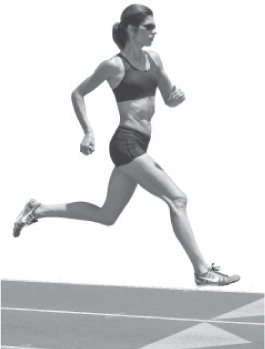
 Blood: 5K pace reps increase blood volume, including your red blood cell count. Again, longer reps are advised.
Blood: 5K pace reps increase blood volume, including your red blood cell count. Again, longer reps are advised.
|
5K Time |
10K Time |
Repetition Paces |
|||
|---|---|---|---|---|---|
|
2000m |
1600m |
1000m |
800m |
||
|
14:00 |
29:10 |
5:50 |
4:40 |
2:55 |
2:20 |
|
14:30 |
30:12 |
6:02 |
4:50 |
3:01 |
2:25 |
|
15:00 |
31:15 |
6:15 |
5:00 |
3:07 |
2:30 |
|
15:30 |
32:17 |
6:27 |
5:10 |
3:14 |
2:35 |
|
16:00 |
33:20 |
6:40 |
5:20 |
3:20 |
2:40 |
|
16:30 |
34:22 |
6:52 |
5:30 |
3:26 |
2:45 |
|
17:00 |
35:25 |
7:05 |
5:40 |
3:32 |
2:50 |
|
17:30 |
36:27 |
7:17 |
5:50 |
3:39 |
2:55 |
|
18:00 |
37:30 |
NA |
6:00 |
3:45 |
3:00 |
|
18:30 |
38:32 |
NA |
6:10 |
3:51 |
3:05 |
|
19:00 |
39:35 |
NA |
6:20 |
3:57 |
3:10 |
|
19:30 |
40:37 |
NA |
6:30 |
4:04 |
3:15 |
|
20:00 |
41:40 |
NA |
6:40 |
4:10 |
3:20 |
|
20:30 |
42:42 |
NA |
6:50 |
4:16 |
3:25 |
|
21:00 |
43:45 |
NA |
7:00 |
4:22 |
3:30 |
|
21:30 |
44:47 |
NA |
7:10 |
4:29 |
3:35 |
|
22:00 |
45:50 |
NA |
NA |
4:35 |
3:40 |
|
22:30 |
46:52 |
NA |
NA |
4:41 |
3:45 |
|
23:00 |
47:55 |
NA |
NA |
4:47 |
3:50 |
|
23:30 |
48:57 |
NA |
NA |
4:54 |
3:55 |
|
24:00 |
50:00 |
NA |
NA |
5:00 |
4:00 |
|
24:30 |
51:02 |
NA |
NA |
5:06 |
4:05 |
|
25:00 |
52:05 |
NA |
NA |
5:12 |
4:10 |
|
26:00 |
54:10 |
NA |
NA |
5:25 |
4:20 |
|
27:00 |
56:15 |
NA |
NA |
5:37 |
4:30 |
|
28:00 |
58:20 |
NA |
NA |
5:50 |
4:40 |
|
29:00 |
1:00:25 |
NA |
NA |
6:02 |
4:50 |
|
30:00 |
1:02:30 |
NA |
NA |
6:15 |
5:00 |
|
31:00 |
1:04:35 |
NA |
NA |
6:27 |
5:10 |
|
32:00 |
1:06:40 |
NA |
NA |
6:40 |
5:20 |
|
33:00 |
1:08:45 |
NA |
NA |
6:52 |
5:30 |
|
34:00 |
1:10:50 |
NA |
NA |
7:05 |
5:40 |
|
35:00 |
1:12:55 |
NA |
NA |
NA |
5:50 |
|
36:00 |
1:15:00 |
NA |
NA |
NA |
6:00 |
|
37:00 |
1:17:05 |
NA |
NA |
NA |
6:10 |
|
38:00 |
1:19:10 |
NA |
NA |
Na |
6:20 |
|
39:00 |
1:21:15 |
NA |
NA |
NA |
6:30 |
|
40:00 |
1:23:20 |
NA |
NA |
NA |
6:40 |
|
41:00 |
1:25:25 |
NA |
NA |
NA |
6:50 |
|
42:00 |
1:27:30 |
NA |
NA |
NA |
7:00 |
Work:Recovery (Time) = 1:½
*The maximum duration of a repetition at 10K pace is 7:07.
10K pace training is a less-intense alternative to 5K pace training. The pace table uses your 5K race pace as a starting point and then estimates your equivalent 10K pace (or just look for your 10K pace); it offers 10K pace suggestions for repetitions at 400, 800, 1000, and 1600 meters (1600 meters is ten yards short of a mile). If you don’t have a current 5K time, use the guidelines outlined on page 34. Repetitions longer than 2000 meters (not shown in table) are not advised. 10K pace reps can improve:
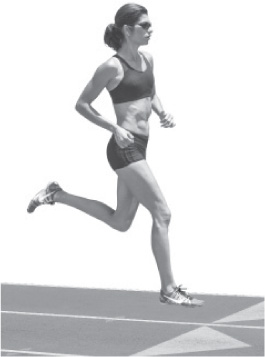
Cruise intervals can be viewed as a less intense version of 10K pace reps or a slightly more intense version of tempo. The pace table uses your 5K race pace as a starting point and then estimates cruise interval paces for repetitions at 400, 800, 1000, 1200, and 1600 meters. If you don’t have a current 5K time, use the guidelines outlined on page 34. Repetitions longer than 8 minutes are not advised. Cruise intervals can improve:

Cruise Interval Training Table
|
5K Time |
Repetition Paces |
||||
|---|---|---|---|---|---|
|
2000m |
1600m |
1200m |
1000m |
800m |
|
|
14:00 |
6:07 |
4:54 |
3:40 |
3:04 |
2:27 |
|
14:30 |
6:20 |
5:04 |
3:48 |
3:10 |
2:32 |
|
15:00 |
6:32 |
5:13 |
3:55 |
3:16 |
2:37 |
|
15:30 |
6:44 |
5:23 |
4:02 |
3:22 |
2:42 |
|
16:00 |
6:56 |
5:33 |
4:10 |
3:28 |
2:47 |
|
16:30 |
7:09 |
5:43 |
4:17 |
3:34 |
2:51 |
|
17:00 |
7:21 |
5:53 |
4:25 |
3:40 |
2:56 |
|
17:30 |
7:33 |
6:02 |
4:32 |
3:47 |
3:01 |
|
18:00 |
7:45 |
6:12 |
4:39 |
3:53 |
3:06 |
|
18:30 |
7:57 |
6:22 |
4:46 |
3:59 |
3:11 |
|
19:00 |
8:09 |
6:32 |
4:54 |
4:05 |
3:16 |
|
19:30 |
8:22 |
6:41 |
5:00 |
4:11 |
3:21 |
|
20:00 |
8:34 |
6:51 |
5:08 |
4:17 |
3:25 |
|
20:30 |
8:46 |
7:00 |
5:15 |
4:23 |
3:30 |
|
21:00 |
8:58 |
7:10 |
5:23 |
4:29 |
3:35 |
|
21:30 |
9:10 |
7:20 |
5:30 |
4:35 |
3:40 |
|
22:00 |
9:22 |
7:29 |
5:37 |
4:41 |
3:45 |
|
22:30 |
9:34 |
7:39 |
5:44 |
4:47 |
3:50 |
|
23:00 |
9:46 |
7:49 |
5:51 |
4:53 |
3:54 |
|
23:30 |
9:58 |
7:58 |
5:59 |
4:59 |
3:59 |
|
24:00 |
10:10 |
8:08 |
6:06 |
5:05 |
4:04 |
|
24:30 |
10:22 |
8:17 |
6:13 |
5:11 |
4:09 |
|
25:00 |
10:34 |
8:27 |
6:20 |
5:17 |
4:13 |
|
26:00 |
10:57 |
8:46 |
6:34 |
5:29 |
4:23 |
|
27:00 |
11:21 |
9:05 |
6:49 |
5:41 |
4:32 |
|
28:00 |
11:45 |
9:24 |
7:03 |
5:52 |
4:42 |
|
29:00 |
12:08 |
9:43 |
7:17 |
6:04 |
4:51 |
|
30:00 |
12:32 |
10:01 |
7:31 |
6:16 |
5:00 |
|
31:00 |
12:55 |
10:20 |
7:45 |
6:28 |
5:10 |
|
32:00 |
13:19 |
10:39 |
7:59 |
6:39 |
5:20 |
|
33:00 |
13:42 |
10:58 |
8:13 |
6:51 |
5:29 |
|
34:00 |
14:06 |
11:16 |
8:27 |
7:03 |
5:38 |
|
35:00 |
14:29 |
11:35 |
8:41 |
7:14 |
5:48 |
|
36:00 |
14:52 |
11:54 |
8:55 |
7:26 |
5:57 |
|
37:00 |
15:15 |
12:12 |
9:09 |
7:38 |
6:06 |
|
38:00 |
15:39 |
12:31 |
9:23 |
7:49 |
6:15 |
|
39:00 |
16:02 |
12:49 |
9:37 |
8:00 |
6:25 |
|
40:00 |
16:25 |
13:08 |
9:51 |
8:12 |
6:34 |
|
41:00 |
16:48 |
13:26 |
10:05 |
8:24 |
6:43 |
|
42:00 |
17:11 |
13:45 |
10:19 |
8:35 |
6:52 |
Work:Recovery (Time) = 1:½
Find your 5K time in the left column. Then use repetition paces in the corresponding row to the right.
Tempo runs are completed at an effort level that über-coach Jack Daniels defines as “comfortably hard.” The tempo-training table offers tempo runs at two different paces: “fast” and “slow.” The faster pace is roughly equivalent to half marathon pace; runs at this pace should last 15–25 minutes. The slower pace is roughly equivalent to marathon pace; runs at this pace should last 20–40 minutes (up to 60 minutes when prepping for a marathon). You can also break tempo efforts into tempo intervals (e.g., 2 × 10 minutes, or 3 × 10 minutes, with 3–4-minute jog recovery intervals). The table bases your tempo paces on your 5K race time. If you don’t have a current 5K time, then choose a pace that, if pressed, you could maintain for an hour (e.g., you run 15 minutes at tempo for your workout, but you believe you could maintain that pace for an hour in a race). Tempo can improve:
|
5K Time |
Fast Tempo |
SlowTempo |
||
|---|---|---|---|---|
|
Mile |
1K |
Mile |
1K |
|
|
14:00 |
5:01 |
3:07 |
5:19 |
3:18 |
|
14:30 |
5:11 |
3:13 |
5:29 |
3:24 |
|
15:00 |
5:21 |
3:20 |
5:40 |
3:31 |
|
15:30 |
5:31 |
3:26 |
5:50 |
3:37 |
|
16:00 |
5:41 |
3:32 |
6:00 |
3:44 |
|
16:30 |
5:51 |
3:38 |
6:11 |
3:50 |
|
17:00 |
6:00 |
3:44 |
6:21 |
3:57 |
|
17:30 |
6:11 |
3:50 |
6:31 |
4:03 |
|
18:00 |
6:21 |
3:56 |
6:42 |
4:10 |
|
18:30 |
6:30 |
4:03 |
6:52 |
4:16 |
|
19:00 |
6:40 |
4:09 |
7:02 |
4:22 |
|
19:30 |
6:50 |
4:15 |
7:12 |
4:29 |
|
20:00 |
6:59 |
4:21 |
7:23 |
4:35 |
|
20:30 |
7:09 |
4:27 |
7:33 |
4:41 |
|
21:00 |
7:19 |
4:33 |
7:43 |
4:48 |
|
21:30 |
7:28 |
4:39 |
7:53 |
4:54 |
|
22:00 |
7:38 |
4:45 |
8:03 |
5:00 |
|
22:30 |
7:48 |
4:51 |
8:13 |
5:06 |
|
23:00 |
7:57 |
4:57 |
8:23 |
5:13 |
|
23:30 |
8:07 |
5:03 |
8:33 |
5:19 |
|
24:00 |
8:16 |
5:08 |
8:43 |
5:25 |
|
24:30 |
8:26 |
5:14 |
8:53 |
5:31 |
|
25:00 |
8:35 |
5:20 |
9:03 |
5:37 |
|
26:00 |
8:54 |
5:32 |
9:23 |
5:50 |
|
27:00 |
9:13 |
5:44 |
9:42 |
6:02 |
|
28:00 |
9:32 |
5:55 |
10:02 |
6:14 |
|
29:00 |
9:51 |
6:07 |
10:22 |
6:26 |
|
30:00 |
10:09 |
6:19 |
10:41 |
6:38 |
|
31:00 |
10:28 |
6:30 |
11:00 |
6:50 |
|
32:00 |
10:46 |
6:42 |
11:20 |
7:02 |
|
33:00 |
11:05 |
6:53 |
11:39 |
7:14 |
|
34:00 |
11:23 |
7:05 |
11:58 |
7:26 |
|
35:00 |
11:42 |
7:16 |
12:17 |
7:38 |
|
36:00 |
12:00 |
7:27 |
12:36 |
7:50 |
|
37:00 |
12:18 |
7:39 |
12:55 |
8:01 |
|
38:00 |
12:36 |
7:50 |
13:13 |
8:13 |
|
39:00 |
12:54 |
8:01 |
13:32 |
8:25 |
|
40:00 |
13:12 |
8:12 |
13:51 |
8:36 |
|
41:00 |
13:30 |
8:23 |
14:09 |
8:48 |
|
42:00 |
13:48 |
8:35 |
14:28 |
8:59 |
Find your 5K time in the left column. Then use the tempo paces in the corresponding row to the right.
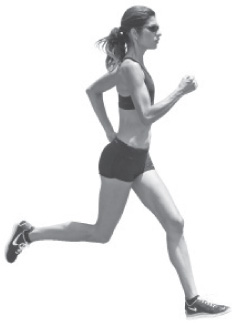
|
5K Time |
Pace per Mile |
Pace per Kilometer |
|---|---|---|
|
14:00 |
6:26–7:29 |
4:00–4:39 |
|
14:30 |
6:39–7:43 |
4:08–4:48 |
|
15:00 |
6:51–7:58 |
4:16–4:57 |
|
15:30 |
7:04–8:12 |
4:23–5:05 |
|
16:00 |
7:16–8:26 |
4:31–5:14 |
|
16:30 |
7:28–8:40 |
4:39–5:23 |
|
17:00 |
7:41–8:53 |
4:46–5:31 |
|
17:30 |
7:53–9:07 |
4:54–5:40 |
|
18:00 |
8:05–9:21 |
5:01–5:49 |
|
18:30 |
8:17–9:34 |
5:09–5:57 |
|
19:00 |
8:29–9:48 |
5:16–6:05 |
|
19:30 |
8:41–10:02 |
5:24–6:14 |
|
20:00 |
8:53–10:15 |
5:31–6:22 |
|
20:30 |
9:05–10:28 |
5:38–6:30 |
|
21:00 |
9:16–10:42 |
5:46–6:39 |
|
21:30 |
9:28–10:55 |
5:53–6:47 |
|
22:00 |
9:40–11:08 |
6:00–6:55 |
|
22:30 |
9:52–11:21 |
6:08–7:03 |
|
23:00 |
10:03–11:34 |
6:15–7:11 |
|
23:30 |
10:15–11:47 |
6:22–7:19 |
|
24:00 |
10:27–12:00 |
6:29–7:27 |
|
24:30 |
10:38–12:13 |
6:36–7:35 |
|
25:00 |
10:50–12:25 |
6:44–7:43 |
|
26:00 |
11:12–12:51 |
6:58–7:59 |
|
27:00 |
11:35–13:16 |
7:12–8:15 |
|
28:00 |
11:58–13:41 |
7:26–8:30 |
|
29:00 |
12:20–14:05 |
7:40–8:45 |
|
30:00 |
12:42–14:30 |
7:54–9:00 |
|
31:00 |
13:04–14:54 |
8:07–9:16 |
|
32:00 |
13:26–15:18 |
8:21–9:31 |
|
33:00 |
13:48–15:42 |
8:34–9:45 |
|
34:00 |
14:09–16:06 |
8:48–10:00 |
|
35:00 |
14:31–16:29 |
9:01–10:15 |
|
36:00 |
14:52–16:52 |
9:14–10:29 |
|
37:00 |
15:14–17:15 |
9:28–10:43 |
|
38:00 |
15:35–17:38 |
9:41–10:58 |
|
39:00 |
15:56–18:00 |
9:54–11:12 |
|
40:00 |
16:16–18:23 |
10:07–11:26 |
|
41:00 |
16:37–18:46 |
10:20–11:40 |
|
42:00 |
16:58–19:08 |
10:32–11:53 |
Find your 5K time in the left column. Then use the long run paces in the corresponding row to the right.
The long run is a staple in every distance runner’s diet. Run once or twice a week—or sometimes once every other week—a long run can account for 20–25 percent of a week’s training volume and can be longer than regular distance runs by 50 percent or more. Use the “Long Run Pace Table” to determine pace, based on your current 5K race pace. If you don’t have a current 5K time, then stick to a conversational pace. All runners should let feedback from their bodies be the final guide; long runs should remain comfortable (i.e., they aren’t endurance competitions). The long run has multiple benefits, including improvements to:
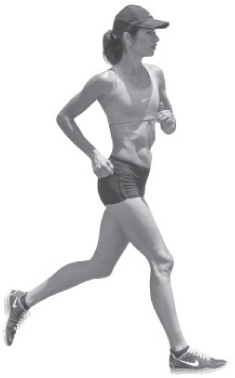
 Non-cardiovascular adaptations: Long runs increase mitochondrial volume in slow-twitch fibers (Chapter 8) and MCTs for transporting lactate (Chapter 9). They also improve nervous system recruitment patterns (Chapter 11) and strengthen connective tissue, allowing you to absorb the impact of higher mileage and longer races. By significantly increasing the efficiency of your stride, the long run improves running economy for all paces.
Non-cardiovascular adaptations: Long runs increase mitochondrial volume in slow-twitch fibers (Chapter 8) and MCTs for transporting lactate (Chapter 9). They also improve nervous system recruitment patterns (Chapter 11) and strengthen connective tissue, allowing you to absorb the impact of higher mileage and longer races. By significantly increasing the efficiency of your stride, the long run improves running economy for all paces.
Hill repeats build a combination of strength, power, and endurance that can’t be replicated by any other training. Find a hill that is challenging but not so steep that you can’t maintain a good stride. Rather than timing each repetition, many runners time the first rep and then mark the spot where that rep ends; on subsequent reps, runners refrain from measuring time and use the mark as a finish line. Proper effort is equivalent to 1500m–3K race effort (not pace, as running uphill slows your pace an indeterminate amount—as hill steepness, terrain, and other factors will vary—making it impossible and counterproductive to target actual pace). Use the “rule of repetitions” for this workout: Always finish knowing you could have run one or possibly two more reps if required. No more than once a week (2–3 times a month) is enough for this workout. Hill reps can improve:

Hill Repeats
|
Rep Length (seconds) |
Rep Volume (number) |
Recovery (minutes) |
|---|---|---|
|
30 |
10–15 |
1–1.5 |
|
45 |
8–12 |
1.5–2 |
|
60 |
6–8 |
2–3 |
|
90 |
4–6 |
4–5 |
|
120 |
4–6 |
4–5 |
Correct effort level for hill reps is equivalent to 1500m–3K effort. Always finish a workout with 1–2 reps left in you.
Off-track 5K effort repetitions are a good alternative for runners looking to improve fitness without having to focus on pace or distance covered for each rep. These reps are run by minutes, not distance, at an effort that approximates the feel of 5K race effort. If you aren’t sure what 5K effort feels like, use the guidelines outlined on page 34. Recovery is an easy jog, nothing harder. For runners who prefer to do preseason training—or all their training—off-track, this 10-week progression is for you. 5K Road and Trail Reps build:

5K Effort Road and Trail Repetitions
|
Progression (weeks) |
Rep Length (minutes) |
Rep Volume (number) |
Recovery (minutes) |
Max Stimulus (minutes) |
|---|---|---|---|---|
|
1 |
1 |
6–8 |
2 |
0 |
|
2 |
2 |
8 |
3 |
0 |
|
3 |
3 |
6 |
3 |
6 |
|
4 |
4 |
4 |
3–4 |
8 |
|
5 |
4 |
5 |
3–4 |
10 |
|
6 |
5 |
4 |
3–4 |
12 |
|
7 |
Substitute 20–30 minutes of Tempo for reps during Week 7. |
NA |
NA |
NA |
|
8 |
3 |
8 |
3 |
8 |
|
9 |
4 |
6 |
3–4 |
12 |
|
10 |
*Mix: Tempo & 5K Reps |
Variable |
3–4 |
NA |
*For mix workouts, you should alternate tempo reps and 5K effort reps with recovery periods (jogging). An example of a mix workout (by minutes per rep/pace) would be: 3/5K, Recovery, 5/5K, Recovery, 7/Tempo, Recovery, 3/5K, Recovery, 5/5K, Recovery, 8/Tempo.
Respiratory training targets the muscles involved in inhalation and exhalation (e.g., diaphragm, external and internal intercostals, abdominals). Stronger respiratory muscles lower both psychological stress and energy consumption. The PowerLung trainer used by Grace (as pictured) comes in four different resistance levels (color-coded) and can be incorporated into running workouts or used in separate training sessions. Some rules for use:
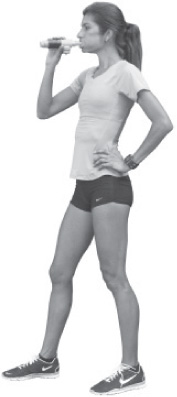
 Whatever your model, set both inhalation and exhalation control dials to “1.”
Whatever your model, set both inhalation and exhalation control dials to “1.”
 Place the mouthpiece in your mouth with the lip guard outside your lips.
Place the mouthpiece in your mouth with the lip guard outside your lips.
 Breathe in, filling your lungs completely in about three seconds.
Breathe in, filling your lungs completely in about three seconds.
 Pause for two seconds, then breathe out, using your abdominals to push out all the air in your lungs in about three seconds.
Pause for two seconds, then breathe out, using your abdominals to push out all the air in your lungs in about three seconds.
 If you need to increase resistance (because the exercise has become too easy), turn the inhalation or exhalation control dials (or both) to the right until your find the correct resistance.
If you need to increase resistance (because the exercise has become too easy), turn the inhalation or exhalation control dials (or both) to the right until your find the correct resistance.